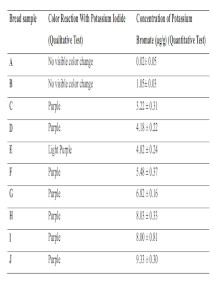Bacteriological examination and potassium bromate analysis of bread samples from selected retail outlets in two locations south west Nigeria
Keywords:
Bacteriological examination, Potassium bromate, Bread, Ibadan, SagamuAbstract
Background: Bread is a staple food prepared from dough of flour and water, usually by baking. It is one of the oldest man-made foods consumed by all socio-economic groups. This study was carried out to evaluate the bacteriological profiles and investigate the potassium bromated additives in bread from retail outlets in south west Nigeria.
Methods: Bread samples homogenates were examined by standard plate count method on different culture media for isolation of Staphylococcus aureus, Esherichia coli, Pseudomonas aeruginosa, Penicillium spp. And Rhizophus spp were also analyzed for the presence of potassium bromate by spectrophotometry. Potassium bromated in the bread samples was quantitively and qualitatively analyzed using spectrometric determination of bromated in bread.
Results: All the 10 samples were found to contain bacteria and molds in varied proportions. Average counts of the isolates for both packed and unpacked bread samples; Staphylococcus aureus,(2.6×104 cfu/g): (4.0× 105 cfu/g), Escherichia coli 1.08× 103 cfu/g : 1.66× 105 cfu/ ) Pseudomonas aeruginosa (0.79× 102 cfu/g): (1.40× 105 cfu/g), Penicillium spp (1.92 × 104 cfu/g): (2.74× 105 cfu/g) and Rhizopus (1.92× 103 cfu/g): (2.71× 105 cfu/g)respectively while the bromate levels ranged from0.02 ± 0.05 ppm to 9.33 ± 0.30 ppm were, an indication of not all bakeries following the standard regulation required by NAFDAC for bread production.
Conclusion: The presence of food poisoning bacteria in the bread examined could be traced to raw material quality, sanitary status of equipment, handlers hygiene, environment and storage condition while the amount of potassium bromate content found could threaten consumers' life when consumed regularly and hence, the needs for strict monitoring by the food and drug regulatory agency.
References
Unachukwu, MN and Nwakanma, C. (2015). The fungi associated with the spoilage of bread in Enugu state. International Journal of Current Microbiology and AppliedScience 4(1): 989-995.
Saranraj P, Geetha M. (2012) Microbial spoilage of bakery products and its control by
preservatives. Int J Pharm Biol Sci Arch.(3):38-48.
Ekop AS., Obot, IB. and Ikpat EN. (2008) Anti-Nutritional Factors and Potassium Bromate Content in Bread and Flour Samples in Uyo Metropolis, Nigeria. Journal of Chemistry Vol 5, Article ID 53096, 6 pages https://doi.org/10.1155/2008/530596
Diachenko GW and Warner, CR (2002). Potassium bromate in bakery products: food technology, toxicological concerns, and analytical methodology. in: Bioactive Compounds in Foods. 2002 ACS Symp. Ser.816. Page 218. T.-C Lee and C.-T Ho, eds. American Chemical Society, Washington, DC.
Oloyede OB, Sunmonu TO (2009). Potassium bromate content of selected bread samples in Ilorin, Central Nigeria and its effect on some enzymes of rat liver and kidney. Food Chemical Toxicology. 47(8) : 2067 - 70 https://doi.org/10.1016/j.fct.2009.05.026
U.S. Department of Agriculture, U.S. Department of Health and Human Services. Dietary 2010 Guidelines for Americans.
APHA, Compendium of Methods for the Microbiological Examination of Foods, American Public Health Association, Washington, DC, USA, 4th edition, 2001.
Ojeka EO, Obidiaku ML, Enukorah C,(2006). Spectrophotometric determination of bromate in bread by oxidation of dyes. Journal of Applied Science Environmental Management. Vol 10 (3) 43-46.
Lukman AA, Maxwell Madueke Nwegbu Bassey Inyang and Kenneth Chiwuba (2013) Determination of Potassium Bromate content in Selected Bread Samples in Gwagwalada, Abuja, Nigeria Int. J. Health Nutr 4 (1): 15-20
Tabashsum Z, Khalil I, Nazim UM, Moniruzzaman MAKM, Inatsu Y, Latiful BMD (2013). Prevalence of food borne pathogens and spoilage microorganisms and their drug resistant status in different street foods of Dhaka City. Agric Food Anal Bacteriol.(3):281-292
Joint FAO/WHO, Expert Committee on Food Additives. Evaluation of certain food additives and contaminants. Geneva, World Health Organization. 1992;25-30.
Nakamura M, Murakami T, Himata K, Hosoya S, Yamada Y(2006). Effects of reducing agents and
baking conditions on potassium bromate in bread. Cereal Foods World.(51) :69-75.
Huq AK., Uddin J., Haque F., Roy P., Hossain B.(2013). Health, Hygiene Practices and Safety Measures of Selected Baking Factories in Tangail Region, Bangladesh; 10(2): 68-75.
Al-Defiery, ME. and Merjan, AF (2015). Mycoflora of mould contamination in wheat flour and storage wheat flour. Mesop. Environ. J. 1(2);18-25.
Abdulkareem. L., Garba. D and Abubakar. A (2014), “A study of cleanliness and sanitary practices of street food vendors in Northern Nigeria”, Advances in Food Science and Technology. 2 (5);2009-215.
Gilbert, RG.(2000). Guidelines for the microbiological quality of some ready-to-eat food samples at the point of sale. Communicable Disease and public health 3: 163-167.

Views | PDF Downloads:
563
/ 321
/ 0
Published
How to Cite
Issue
Section
License

This work is licensed under a Creative Commons Attribution-NonCommercial 4.0 International License.


